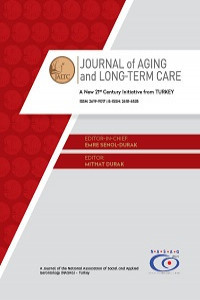Theories of aging and late adulthood with film analysis method from Virginia Satir’s framework: "On Golden Pond"
Theories of aging and late adulthood with film analysis method from Virginia Satir’s framework: "On Golden Pond"
Virginia Satir is one of the leading theorists in the field of family counseling and therapy. In the literature, concepts such as family balance, family communication types, family self-regard are some essential aspects of Virginia Satir’s family counseling theory, which is one of the most influential theories that enable applications on the family cases and its dynamics; these concepts are also functional in many areas and bring a different perspective to look at older ages and late adulthood. The aim of this study is to examine the theories of developmental psychology and social psychology in adulthood and later adulthood, together with the basic concepts of Virginia Satir’s family therapy. In this respect, the examination of later adulthood will be carried out with the film analysis method by examining the “On Golden Pond” movie.
Keywords:
Family, Satir’s family therapy, adulthood, later adulthood film analysis,
___
- Akcay, C. (2011). Old Age: Concepts, Theories, and Preparation (Yaslilik: Kavramlar, Kuramlar ve Yasliliga Hazirlik). Istanbul: Kriter Publishing House.
- Baran, A. G. (2004). Sociology of Old Age [Yaslilik Sosyolojisi]. In V. Kalinkara (Ed.), Aging: Interdisciplinary Approach, Problems, Solutions [Yaslilik: Disiplinler Arasi Yaklasim, Sorunlar, Cozumler] (pp. 35-57). Ankara: Odak Yayın Evi.
- Bitter, J. R. (1988). Family mapping and family constellation: Satir in Adlerian context. Individual Psychology: Journal of Adlerian Theory, Research & Practice, 44(1), 106-111.
- Buhler, C. (1957). About the goal-structure of human life: Theoretical considerations. Dialectica, 11(1), 187-205.
- Cheung, G., & Chan, C. (2002). The Satir model and cultural sensitivity: A Hong Kong reflection. Contemporary Family Therapy, 24(1), 199-215.
- Dermer, S. B. & Hutchings, J. B. (2000). Utilizing movies in family therapy: Applications for individuals, couples, and families. The American Journal of Family Therapy, 28, 163-180
- Durak, M. (2019). Psychosocial and Cognitive Development in Old Age [Yaslilik Doneminde Psikososyal ve Bilissel Gelisim]. In H. Bacanlı & S. Terzi (Eds.), Adulthood and Old Age: Development and Psychology [Yetiskinlik ve Yaslilik: Gelisimi ve Psikolojisi] (5th ed., pp. 205-236). Ankara: Pegem Academy.
- Emiroglu, V. (1995). Aging and Social Adaptation of the Older Adults [Yaslilik ve Yaslinin Sosyal Uyumu]. Ankara: Safak Matbaacılık.
- Erikson, E. H. (1968). Identity: Youth and Crisis (1st ed.). New York: W.W. Norton & Company, Inc.
- Gilbert, B. (Producer) & Rydell, M. (Director). (1981). On Golden Pond. [Motion picture]. USA: ITC Entertainment.
- Hooymann, N. & Kiyak, A. (1991). Social Gerontology: A Multidisciplinary Perspective (2nd. ed.).Washington, DC: Allyn & Bacon.
- Innes, M. (2002). Satir’s therapeutically oriented educational process: A critical appreciation. Contemporary Family Therapy, 24(1), 35-56.
- Isik, C. (2002). Nursing Home and Old Age: In the Case of Izmir Metropolitan Municipality Zubeyde Hanım Nursing Home [Huzurevi ve Yaslilik: Izmir Büyüksehir Belediyesi Zubeyde Hanim Huzurevi Orneginde]. (Unpublished Master’s Dissertation). Ege University, Graduate School of Social Sciences, Izmir.
- Kalinkara, V. (2004). Aging: Interdisciplinary Approach, Problems, Solutions [Yaslilik: Disiplinler Arasi Yaklasim, Sorunlar, Cozumler] (1st ed.). Ankara: Odak Yayınları.
- Kalinkara, V. (2016). Basic Gerontology: The Science of Aging [Temel Gerontoloji: Yaslilik Bilimi] (3rd ed.). Ankara: Nobel Yayınevi.
- Lee, B. K. (2002). Congruence in Satir’s model: Its spiritual and religious significance. Contemporary Family Therapy, 24(1), 57-78.
- Onur, B. (1991). Developmental Psychology [Gelisim Psikolojisi]. Ankara: Imge Kitabevi. Satir, V. (1964). Conjoint Family Therapy: A Guide to Theory and Technique (4th ed.). USA: Science & Behavior Book.
- Satir, V. (1964). Conjoint Family Therapy: A Guide to Theory and Technique (4th ed.). USA: Science & Behavior Book.
- Satir, V. (2001). The New Peoplemaking [Insan Yaratmak: Aile Terapisinin Basyapiti] (S. Yeniceri, Trans. 1st ed.). Istanbul: Beyaz.
- Satir, V., & Baldwin, M. (1983). Satir Step by Step: A Guide to Creating Change in Families. Palo Alto, CA: Science & Behavior Books.
- Satir, V., Banmen, J., Gerber, J., & Gomori, M. (1991). The Satir Model: The Family and Beyond. Palo Alto, CA: Science & Behavior Books.
- Senol-Durak, E., & Fisiloglu, H. (2007). An overview to Virginia Satir family therapy approach with the method of film analyses [Film analizi yontemi ile Virginia Satir aile terapisi yaklasimina bir bakis]. Türk Psikoloji Yazıları, 10(20), 43-62.
- Thompson, J. D. (1976). Organizations While Working: The Scientific Foundation of Management Theory in Society [Orgutler Calisirken: Yonetim Teorisinin Toplum Bilimsel Temeli] (U. Sozen & T. Ucok, Trans.). Ankara: Kalite Matbaası.
- ISSN: 2619-9017
- Başlangıç: 2017
- Yayıncı: Ulusal Sosyal ve Uygulamalı Gerontoloji Derneği
